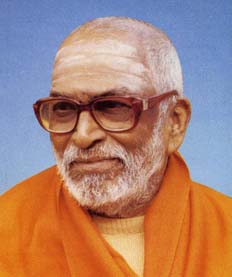
Jagad Guru Ramanandacharya

 His HolinessJagadguru Ramanandacharya
Swami Shri Rajiv Lochanacharyaji, is a personification of piety, penance, and
divinity. It is not surprising therefore, when he was conferred the honor of
'Jagadguru or 'world spiritual master at the Maha Kumbha Mela at Haridwar in
April 1998. It made His Holiness the youngest Jagadguru, at 36 years, after
the first Jagadguru, Adi
Shankaracharyaji 1200 years ago. His HolinessJagadguru Ramanandacharya
Swami Shri Rajiv Lochanacharyaji, is a personification of piety, penance, and
divinity. It is not surprising therefore, when he was conferred the honor of
'Jagadguru or 'world spiritual master at the Maha Kumbha Mela at Haridwar in
April 1998. It made His Holiness the youngest Jagadguru, at 36 years, after
the first Jagadguru, Adi
Shankaracharyaji 1200 years ago.The elevation to the position of Jagadguru starts from a Sadhu to a Swami (Mandaleshwar); to a Maha Mandaleshwar. One out of 108 Maha Mandaleshwars is elevated to the title of Acharya Maha Mandaleshwar and one out of 1008 Acharya Maha Mandaleshwars is given the honor of Jagadguru by the entire saint community of India. To achieve that at such a young age is nothing short of miraculous. Jagadgurujis divinity took its loots even before his birth. His parents went to Lord Jagannaths temple in Puri in Orissa, India, to pray for a son after they were blessed earlier with daughters. His Holiness was born after that. Through the years Jagadguruji rose above the sense-gratifying forces to carry on his mission of spreading peace, love and compassion for all humanity with the sacrosanct system of 0m Kriya Yoga. This system of Om Kriya Yoga, originating from Lord Shiva (the third of the Trinity), was taught by Lord Krishna to the Pandava prince Arjuna on the battlefields of Kurukshetra as described in the Bhagavad Gita. His Holiness received the divine wisdom from the celestial being Mahaavatar Kriya Babaji of 'Autobiography of a Yogi' by ParamahamsaYogananda, fame. It is a system of using the sound of the Brahmanada or OM (the original sound at the time of creation) to awaken the kundalini or the enormous potential power in us. It helps to create cosmic energy in us and enables us to feel the vibration and see the light of God. This results in the cleansing of our being and elevation of our consciousness from the animalistic propensities to the divine level. Jagadguruji is blessed by his spiritual master Brahmarishi Barfani Dadaji, regarded as the greatest living saint in India, who also stayed with Mahaavatar Kriya Babaji for 36 years. Under his guidance, Jagadguruji has mastered spiritual sciences like Srividya, Ayurveda, Kundalini Yoga among many others, Jagadguruji was directed by Mahaavatar Kriya Babaji, who revealed himself before him in Mount Kailash in 1995, to teach this science of self-realization to the people irrespective of their nationality, caste, creed, religion or sex and help them drink the divine nectar of Gods love. Jagadguruji has created the Om Kriya Yantra in response to his realizations. Ishwar, God is the Supreme Being; Sadhana, the discipline of life; Karma, the rightful duties; Love, essence of God; Seva, ego and selfless service; Meditation, concentration of mind. It is his mission to bring about world peace through love, service and meditation. His Holiness has graciously traveled to numerous countries all over the world to preach the sacrosanct system of 0m Kriya Yoga to humanity. He has attended conferences in the U.S.A., Holland, U.K., South Africa, among others and Trinidad, where he was invited by the Prime Minister. He has created 0m Kriya Yoga foundation, a non-profit, religious foundation that would help spread his message throughout the US and the world. His Holiness JagadGuru Ramanandacharya by accepting the "tridanda" (Three Holi Sticks from God) has made an unwavering resolution to use all that he possesses in the service of mankind. Divine Immortal soul Brahmarishi Barfani Dadaji and Mahavtar Kriya Babaji Blessed him and said, " Go and serve humanity! Create peaceful spiritual environment in the world through Om Kiya Yog where peoples may acquire Ananda (happiness). Serve the Poor and destitute without any consideration of cast, creed, religion and show them the right way, that have strayed from the path to true happiness." |






jpg.jpg)






